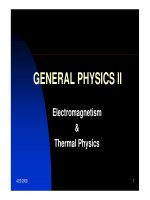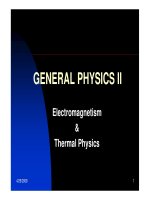- Trang chủ >>
- Khoa Học Tự Nhiên >>
- Vật lý
Tài liệu Chapter XV The First Law of Thermodynamics pdf
Bạn đang xem bản rút gọn của tài liệu. Xem và tải ngay bản đầy đủ của tài liệu tại đây (785.25 KB, 27 trang )
4/29/2008 1
GENERAL PHYSICS II
Electromagnetism
&
Thermal Physics
4/29/2008 2
Chapter XV
The First Law of
Thermodynamics
§1. Heat, work and paths of a thermodynamic process
§2. The first law of thermodynamics
§3. Kinds of thermodynamic processes
§4. Thermodynamic processes for an ideal gas
4/29/2008 3
We knew that the concepts of mechanical work and energy play an
important role in studying mechanical phenomena.
Concerning to thermal phenomena, there exits a new form of energy
called “heat”:
Heat can be transferred from one to other systems
For a system with volume held constant, the effect of heat is to
change the temparature of a system.
In general cases, for a system there exist, at the same time, transfer
or exchange of heat and mechanical work
→ the GOAL of thermodynamics is the study of
the relationships involving
heat, mechanical work, the laws that govern energy transfers
4/29/2008 4
§1. Thermodynamic systems and processes:
1.1 Thermodynamic systems, heat and work:
In any study of heat, work transfer we must define exactly what are
the objects under consideration:
A thermodynamic system is any collection of objects that is
regarded as a unit and that may have the potential to exchange
energy with other bodies beside the system
All the other bodies which have energy exchanges with the
considered system are called surroundings or environment
4/29/2008 5
Then we must fix the convention on the symbol
for heat and work:
We will always denote
by Q the quantity of heat added to the system
by W the mechanical work done by the system
Therefore Q and W are understood as algebraic
values, they can be positive, negative or zero.
system
surroundings
system
surroundings
system
surroundings
system
surroundings
Q > 0
Q < 0
W > 0
W < 0
Work is done by the system
Work is done on the system
4/29/2008 6
1.2 Calculation of work done during volume changes:
A typical example of a thermodynamic system
is an amount of gas enclosed in a cylinder
with a movable piston. (Such a system is the
central part of heat engines: locomotive,
engine of a car, refrigerator,…).
dx When a gas expands, it does work on its
environment. For a small displacement dx,
the work done by the gas is:
dW
by
= F dx = p A dx = p (A dx)= p dV
A
Consider the expansion of gas of from an initial state (with the volume
V
1
) to a final state (the volume V
2
). The system (gas) passes through
a series of intermediate states. We assume the changes of states are
slow enough, then every intermediate state can establish equilibrium,
and has determined values of p, V, T.
4/29/2008 7
Note that when the gas expands, V
2
> V
1
→ W
by
> 0 , and when
the gas is compressed, V
2
< V
1
→ W
by
< 0 (it means that the
surroundings does work on the gas).
In a p-V diagram, the equilibrium intermediate states are represented
by the points on a curve, and the work is represented as the area under
the curve
The work done by the gas during the whole change V
1
→ V
2
is
2
1
V
V
by
pdVW
p
V
V
2
V
1
4/29/2008 8
1.3 Paths between thermodynamic states:
When a thermodynamic system changes from an initial state to a final
state, it passes through a series of (equilibrium) intermediate states.
However, with the same initial and final states, the system can pass in
very different ways. On a P-V diagram, every way corresponds to a
curve which is called the path between thermodynamic states.
Examples: Two different paths between the states 1 and 2 :
V
p
p
V
1
2
3
1
2
4
1 → 3 : keep the pressure constant
at p
1
while the gas expands
to the volume V
2
3 → 2 : reduce the pressure to p
2
at
constant volume V
2
p
1
V
2
p
1
p
2
p
2
1 → 4: reduce the pressure
at the constant volume V
1
4 → 2: keep the pressure
constant at p
2
while the gas
expands to the volume V
2
V
1
4/29/2008 9
It is important to remark that with the same intial and final states:
The work done by the system depends on the intermediate states,
that is, on the path,
Like work, the heat which the system exchanges with the
surroundings depends also on the path.
p
V
1
2
p
V
1
2
Examples:
In an isothermal expansion of the gas
we must supply an input heat to keep
constant temperature
Gas can expand in an
container which is isolated
from surroundings (no heat
input)
4/29/2008 10
§2. The first law of thermodynamics:
2.1 Internal energy of a system:
The internal energy of a system is the energy that the system owns.
We can define:
(Note that the internal energy does not include potential energy arising
from the interaction between the system and its surroundings, for
example, system and gravitaitonal field).
Internal energy = ∑kinetic energies of constituent particles
+ ∑potential energies between them
For an ideal gas we know how can calculate the internal energy. But
for any real system, the calculation of the internal energies by this way
would be very complicated.
4/29/2008 11
We have another way. Practically, in the study of thermodynamical
processes, we can determine not just the interal energy U , but the
change in internal energy ΔU .
We can choose by convention the internal energy of the system
at any reference state, and then knowing ΔU we can determine
U at all other states.
(Recall that the potential energy of a particle in a gravitational field,
or the potential energy of a charge in the static electric field are
defined with the precision to an adding constant).
Having the concept of the internal energy, we can formulate
the first law of thermodynamics
4/29/2008 12
2.2 Formulation of the first law of thermodynamics:
Consider a change of state of the system from an initial value U
1
to a final value U
2
, then ΔU = U
2
– U
1
.
If the change is due to the addition of a quantity of heat Q with
no work done → the inernal energy increases, and ΔU = Q .
If the system does work W by expanding and no heat is added,
the internal energy decreases, we have ΔU = - W
The first law of thermodynamics states that when both heat transfer
and work occur, the total change in internal energy is
ΔU = Q - W
Note: Always remember the convention on the signs of Q and W
given before !!!
4/29/2008 13
§3. Kinds of thermodynamic processes:
We know that there are many different paths between thermodynamic
states. We will study four specific kinds of thermodynamic processes
which are important in practical applications.
3.1 Adiabatic process:
Definition: Adiabatic process is defined as
one with no heat transfer
into or out of a system, Q = 0.
Examples:
Gas in a container which is surrounded by a thermally isolating
material
A expansion (or compression) of gas which takes place so quickly
that there is not enough time for heat transfer.
From the 1
st
law: ΔU = U
2
– U
1
= - W (adiabatic process)
p
V
1
2
4/29/2008 14
3.2 Isochoric process:
Definition: This is a constant-volume process.
Example: A gas in a closed constant-volume
container.
When the volume of a thermodynamic system is
constant, it does no work on its surroundings
W = 0
From the 1
st
law: ΔU = U
2
– U
1
= Q (isochoric process)
V
p
1
2
Since the system does no work → all the energy (heat) added
remains in the system → the iternal energy increases.
4/29/2008 15
3.3 Isobaric process:
Definition: This is a constant-pressure
process.
In a isobaric process, none of three
quantities
Δ
U, Q, W is zero.
V
p
1 2
Work done by the system is easily calculated:
W = p (V
2
– V
1
)
4/29/2008 16
3.4 Isothermal process:
Definition: This is a constant-temperature
process
To keep temprature constant, the system must
exchange heat with the surroundings, and the
exchange must be slowly that thermal equilibrium
is maintained.
p
V
1
2
In general, in a isothermal process, none of ΔU, Q, W is zero
Only in the case of an ideal gas, the internal energy U ~ T
→ ΔU = 0 in a isothermal process.
4/29/2008 17
§4. Thermodynamic processes for an ideal gas:
In this section, by applying the 1
st
law of thermodynamics we study
in more details thermodynamic processes for an ideal gas.
For an ideal gas, with the help of kinetic-molecular model, we know that
the internal energy of an ideal gas depends only on its temperature, not
on its pressure or volume.
Owing to the explicit relation between the internal energy U and
temperature T we can find explicit equations which relate heat, work
and internal energy.
4/29/2008 18
4.1 Constant-volume and constant-pressure heat capacities
of an ideal gas:
We knew the concept of heat capacity of an ideal gas in a
constant-volume process. Now consider more general cases of
thermodynamic process.
The general definition of heat capacity is the following equation:
where ΔQ is the quantity of heat added to the system for increase
ΔT in temperature.
This definition can give rise different heat capacities which depend
on the paths of thermodynamic process.
4/29/2008 19
The constant-volume heat capacity is defined by
Notes:
Here we replace ΔQ by ΔU because no work done in the process
If we understand C
V
as molar constant-volume heat capacity, then
ΔQ is the heat added per mole
The constant-pressure heat capacity:
For a constant-pressure process the effect of the heat added to the
system is twofold: to increase the internal energy and to do work
4/29/2008 20
• Applying the 1
st
law we can write
• At the limit ΔT → 0 :
• In the case of an ideal gas, U depends only on T , we have
• Using the equation of state of an ideal gas we obtain the relation
for the molar heat capacities C
P
and C
V
:
C
P
= C
V
+ R
(See experimantal values of C
V
and C
P
given in textbook, p. 740,
tab. 19.1)
4/29/2008 21
4.2 Isothermal processes for an ideal gas:
For a fix amount of ideal gas, from the
state equation thermal processes are
represented by P-V curves shown in
the picture.
These curves are called isotherms.
Calculate the work done by the gas
in the isothermal expansion A → B
with a fixed temperature T = T
0
(see the picture):
where K = n R, n is the number of moles.
4/29/2008 22
For the case of an ideal, the internal energy U depends only on
temperature → ΔU = 0 in isothermal processes. By the 1
st
law,
the heat added to the gas for keeping constant temperature equals
to the work done by the gas:
Q = W
4.3 Adiabatic processes for an ideal gas:
According to the definition, in an adiabatic process no heat transfer
takes place → Q = 0
Remember for an ideal gas, U depends only on temperature T, and
→ for an adiabatic expansion (or compression) of gas, from 1
st
law
we have
Q = ΔU + P ΔV = C
V
ΔT + P ΔV = 0
4/29/2008 23
For n moles of ideal gas n C
V
ΔT = - P ΔV = - n(RT/V) ΔV
apply the state equation
for n moles of ideal gas
0
V
dV
C
R
T
dT
V
For an infinitesimal process we have
11
V
P
V
VP
V
C
C
C
CC
C
R
V
P
C
C
where
(the ratio of heat
capacities)
0)1(
V
dV
T
dT
(γ-1) is always positive !
4/29/2008 24
constantln)1(ln
VT
constantlnln
1
VT
constant)ln(
1
TV
constant
1
TV
By integrating we obtain
It means that for an adiabatic process from a initial state (T
1
, V
1
)
to a final state (T
2
, V
2
) :
1
22
1
11
VTVT
We can convert the relation for (T, V) into a relation for (p, V)
by substituting
nR
PV
T
constant
1
V
nR
PV
It means that for an adiabatic process:
2211
VPVP
constant
PV
4/29/2008 25
• Adiabatic curves: blue dashed
• Isoterms: solid black
)()(
2112
TTnCTTnCUW
VV
Calculate the work done by the gas. From the 1
st
law:
Using PV = n RT we have
)(
1
1
)(
22112211
VPVPVPVP
R
C
W
V
P-V curves for adiabatic processes
are shown in the picture, together with
isoterms for comparison.
Remark:
Adiabatic curves are more sloping
than isoterms
constant
PV
constant
PV
(Compare
with )
An adiabatic expansion (for
example A → D) causes a drop
in temperature (T
2
→ T
1
)









